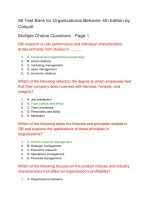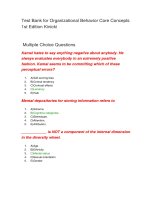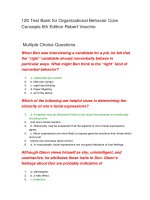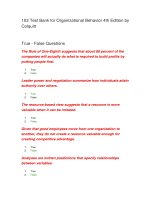Organizational behavior core concepts by kinicki chapter2
Bạn đang xem bản rút gọn của tài liệu. Xem và tải ngay bản đầy đủ của tài liệu tại đây (506.37 KB, 39 trang )
2
Organizational Behavior
core concepts
Perception and Diversity:
Why Viewpoints Differ
2-2
McGraw-Hill/Irwin
Organizational Behavior, Core Concepts
Copyright © 2008 by the McGraw-Hill Companies, Inc. All rights reserved.
Learning Objectives
• Describe perception in terms of the social
information processing model
• Give examples of how social perception affects
organizational behavior
• Explain how individuals formulate causal
attributions
• Discuss why diversity is important in today’s
organizations
• Summarize organizational practices for
managing diversity
2-3
Social Perception: A Social
Information Processing Model
Figure 4-1
2-4
Figure 2-1
A Social Information Processing
Model of Perception
• Perception
– the process of interpreting one’s
environment.
2-5
A Social Information Processing
Model of Perception
Social perception involves a four-stage
information processing sequence
1. Selective attention/comprehension
2. Encoding and simplification
3. Storage and retention
4. Retrieval and response
2-6
Stage 1: Selective
Attention/Comprehension
• Attention
– being consciously aware of
something or someone
• Salient
– something that stands out from context
2-7
Stage 2: Encoding and
Simplification
• Cognitive categories
– mental depositories for storing information
• Schema
– mental picture of an event or object
2-8
Question?
What is a belief about the characteristics of a
group?
A. Consensus
B. Stereotype
C. Personality
D. Trait
2-9
Stage 2: Encoding and
Simplification
• Stereotype
– belief about the characteristics of a group
• Not always negative
• May or may
not be accurate
2-10
Stage 2: Encoding and
Simplification
• Stereotypes
– Can lead to poor decisions
– Can create barriers for older individuals,
people of color, and people with disabilities
– Can undermine loyalty and job satisfaction
2-11
Stereotyping Process
1. Categorize people into groups according to
various criteria
2. Infer that all people within a category possess
the same traits
3. Form expectations of others and interpret
their behavior according to our stereotypes
2-12
Stereotyping Process
4. Stereotypes are maintained by:
• Overestimating the frequency of
stereotypic behavior exhibited by others
• Incorrectly explaining expected and
unexpected behaviors
• Differentiating minority individuals from
oneself
2-13
Common Perceptual Errors
2-14
Stage 3: Storage and Retention
• Event memory
– information about both specific and general
events
• Semantic memory
– general knowledge about the world, mental
dictionary of concepts
• Person memory
– information about a single individual or
groups of people
2-15
Stage 4: Retrieval and Response
• Decisions are based:
– On the process of drawing on, interpreting,
and integrating categorical information
stored in long-term memory
– Retrieving a summary judgment that was
already made
2-16
Cultural Influences:
Perceptions of Time
• Monochronic time
– preference for doing one thing at a time
because time is limited, precisely
segmented, and schedule driven
• Polychronic time
– preference for doing more than one thing at
a time because time is flexible and
multidimensional
2-17
Managerial Implications: Hiring
• Interviewers make hiring decisions based on
their impression of how an applicant fits the
perceived requirements of a job
• Inaccurate impressions
in either direction
produce poor hiring
decisions
2-18
Managerial Implications:
Performance Appraisal
• Important for managers to accurately identify
the behavioral characteristics and results
indicative of good performance
• Characteristics serve as the benchmarks for
evaluating employee performance
2-19
Managerial Implications:
Leadership
Good leaders exhibit the following behaviors:
– Assigning specific tasks to group members
– Telling others they had done well
– Setting specific goals for the group
– Letting other group members make
decisions
– Trying to get the group to work as a team
– Maintaining definite standards of
performance
2-20
Managerial Implications:
Leadership
• Poor leaders exhibit the following behaviors:
– Telling others they had performed poorly
– Insisting on having their own way
– Doing things without explaining themselves
– Expressing worry over the group members
suggestions
– Frequently changing plans
– Letting the details of the task become
overwhelming
2-21
Causal Attributions
• Causal Attributions
– suspected or inferred causes of
behavior
2-22
Kelley’s Model of Attribution
• Internal factors
– personal characteristics that cause behavior
• External factors
– environmental characteristics that cause
behavior
2-23
Question?
What involves comparing a person’s behavior on
one task with the behavior from other tasks?
A. Consensus
B. Distinctiveness
C. Consistency
D. Personality
2-24
Kelley’s Model of Attribution
• Consensus
– involves a comparison of an individual’s
behavior with that of his peers.
• Distinctiveness
– involves comparing a person’s behavior on
one task with the behavior from other tasks.
• Consistency
– determined by judging if the individual’s
performance on a given task is consistent
over time.
2-25









